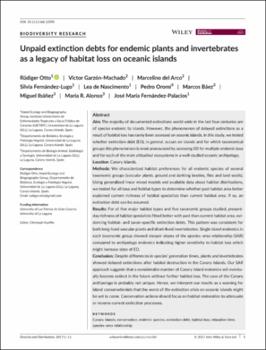Unpaid extinction debts for endemic plants and invertebrates as a legacy of habitat loss on oceanic islands
Fecha
2017Resumen
Aim: The majority of documented extinctions world-wide
in the last four centuries are
of species endemic to islands. However, the phenomenon of delayed extinctions as a
result of habitat loss has rarely been assessed on oceanic islands. In this study, we tested
whether extinction debt (ED), in general, occurs on islands and for which taxonomical
groups this phenomenon is most pronounced by assessing ED for multiple endemic taxa
and for each of the main altitudinal ecosystems in a well-studied
oceanic archipelago.
Location: Canary Islands.
Methods: We characterized habitat preferences for all endemic species of several
taxonomic groups (vascular plants, ground and darkling beetles, flies and land snails).
Using generalized linear mixed models and available data about habitat distributions,
we tested for all taxa and habitat types to determine whether past habitat area better
explained current richness of habitat specialists than current habitat area. If so, an
extinction debt can be assumed.
Results: For all five major habitat types and five taxonomic groups studied, present-day
richness of habitat specialists fitted better with past than current habitat area, evidencing
habitat-and
taxon-specific
extinction debts. This pattern was consistent for
both long-lived
vascular plants and short-lived
invertebrates. Single island endemics in
each taxonomic group showed steeper slopes of the species–area relationship (SAR)
compared to archipelago endemics indicating higher sensitivity to habitat loss which
might increase sizes of ED.
Conclusion: Despite differences in species’ generation times, plants and invertebrates
showed delayed extinctions after habitat destruction in the Canary Islands. Our SAR
approach suggests that a considerable number of Canary Island endemics will eventually
become extinct in the future without further habitat loss. The case of the Canary
archipelago is probably not unique. Hence, we interpret our results as a warning for
island conservationists that the worst of the extinction crisis on oceanic islands might
be yet to come. Conservation actions should focus on habitat restoration to attenuate
or reverse current extinction processes.






